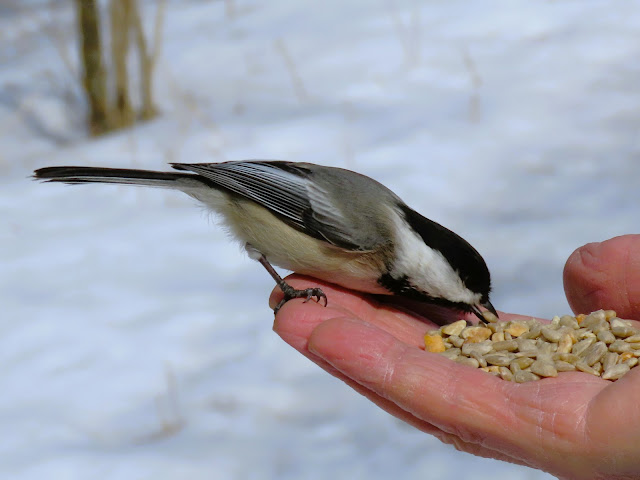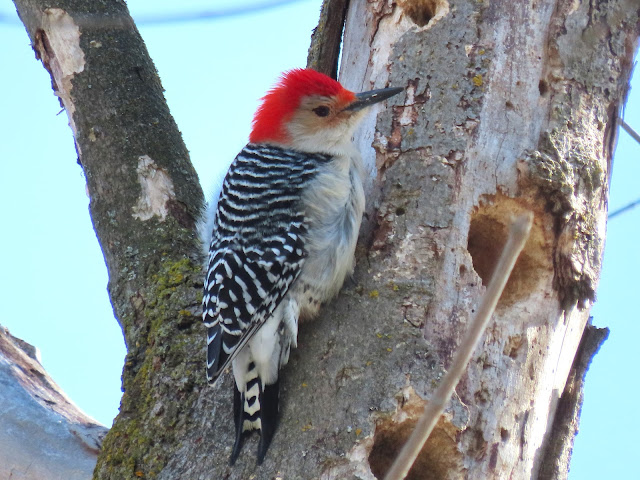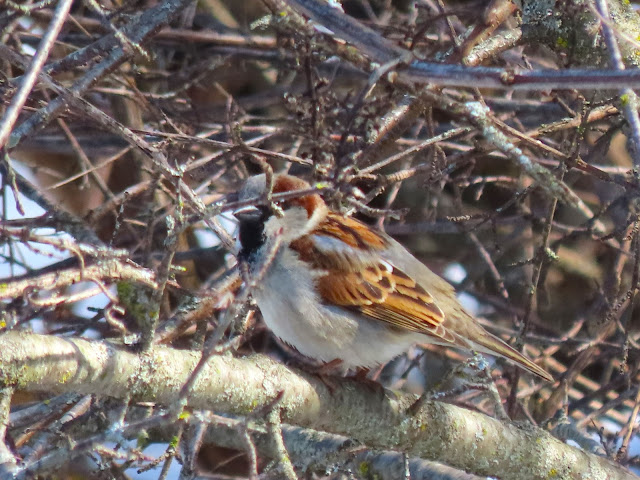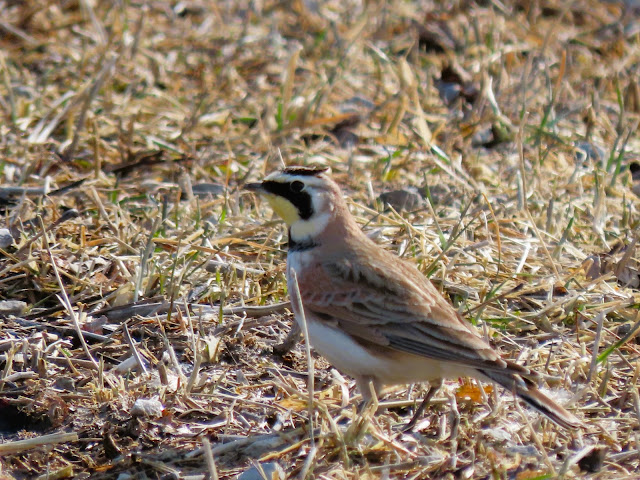Joy is not made to be a crumb.
Mary Oliver
Having blogged about Cuba exclusively for the past month or so, other than for book reviews, there are various odds and ends in the files, and this post will feature a few highlights, with no set pattern or theme.
First is a great picture Victoria took of Selwyn, Miriam and me at Algonquin Provincial Park. Victoria says, "You all looked so happy," - and indeed we were.
An American Robin (Turdus migratorius) showed a distinct preference for a seed bell in our backyard, and became very adept at perching on it and feeding contentedly.
Mourning Dove (Zenaida macroura) is a very common visitor, and I thought that this image next to the Snowdrops was especially endearing.
We have just this one small clump of Snowdrops, courtesy of the squirrels I assume, since we didn't plant it.
For just a couple of days in March Pine Siskins (Spinus pinus) visited our feeders.
The males are all in full voice, proclaiming territory and seeking a mate - and pleasing humans too!
This female Hairy Woodpecker (Leuconotopicus villosus) would visit for three or four days in a row, and then disappear for a week.
Red-breasted Nuthatch (Sitta canadensis) as a general rule visits our feeders far less commonly than White-breasted Nuthatch (Sitta carolinensis).
It is a bold little bird and when I was outside it showed not the slightest inclination to flee and would often perch within arm's length.
In mid March, at Hillside Park in Waterloo, winter had not yet released its grip.
Black-capped Chickadees (Poecile atricapillus) are hardy residents, and always a joy to come across.
In the area shown below we have had success in the past in finding Barred Owl (Strix varia), but there was no such luck this time.
It is about as sure as death and taxes that within a minute or two of setting foot on the Mill Race Trail in St. Jacobs, friendly chickadees will put in an appearance.
Eastern Chipmunks (Tamias striatus) have emerged from their winter hibernation and enliven our walks with their mischievous ways.
If I were to create a "Can't Miss" list I would add Downy Woodpecker (Dryobates pubescens) to the roster to form a trio along with the nuthatch and the chickadee.
A male Red-bellied Woodpecker (Melanerpes carolinensis) was excavating a nest hole, while at the same time keeping a wary eye on Common Starlings (Sturnus vulgaris) anxious to wrest it from him.
A Song Sparrow (Melopsiza melodia) was joined at the water's edge by a couple of female Northern Cardinals.
In the interests of fair play, having presented a male Mallard above, here is a female, and very beautiful she is too.
On the way home, we spotted several Horned Larks (Eremophila alpestris), and while they can be frustratingly difficult to photograph, this one stayed in one spot for a few seconds and Miriam captured its portrait.
Trivia
Recently someone asked me about melanin and its function as it applies to birds.
Melanin has several functions but as it relates to avian plumage it inhibits the growth of bacteria, and contributes to the structural strength of feathers. It offers protection against ultraviolet light, and when individuals have a genetic disorder that inhibits the deposition of melanin, it leads to pale colouration in feather tracts, a condition known as leucism.
















































...that more snow than I saw here this winter, I'm jealous!
ReplyDeleteI Saw a Red-bellied Woodpecker along the boardwalk this past winter which is an unusual sight for the island. People saw them in a few areas. I also saw a female Red-winged Blackbird which was an unusual sight too. They normally head south in late August/September. I’ve never seen a Horned Lark. That would be a treat. I have come to know most of these birds the last few years and you have been part of the reason for that, David. Thanks to you both! Great photos, Miriam.
ReplyDeleteI am glad I could be of help, Marie.
DeleteSpending time in nature is one of the best things we can do...
ReplyDeleteAnd that's why I do it every day.
DeleteA great collection of photos, love the variety of birds seen too. Have a great day!
ReplyDeleteYou have an eye out all the time for the birds and capture them beautifully. By the way, we are headed to Halifax.NS in May for three nights. Any suggestions? We won't have a car.
ReplyDeleteI have only ever visited Halifax once, about forty years ago, so I am not much help!
DeleteHari OM
ReplyDeleteNothing beats a little rummage around what's left in the files, eh?! A lovely post. YAM xx
You have seen lots of beautiful birds these past days! Meisen - like chikadees - are my most frequent visitors, but jays and wood pigeons have been enjoying the food, too. And it's fun watching the male pigeon trying to woo his lady with bowing and scraping! Hugs, Valerie
ReplyDeleteNature is wonderful and people ought to appreciate it more.
ReplyDeleteIt's a beautiful photo of you in the snow! Snow is lovly in photos in winter, but now I want to see the snow melt. I don't think it's the squirrels who take the snowdrop seeds, but the ants. Here in ny garden they spread many seeds. A plant called Hepatica nobilis spreads their seeds by stick to the legs of the ant. I have got many of them in my garden thanks to the ants.
ReplyDeleteBeautiful photos of the birds.
Hugs and kisses, Marit
What a beautiful birds!! Happy weekend
ReplyDeleteLa felicidad, se puede encontrar en cualquier parte y en el mundo que nos rodea.
ReplyDeleteCon tan sólo observar la belleza de la Naturaleza, el aire limpio y puro que se respira y esa aves que alegremente se encuentra disfrutando de su libertad.
No hay nada más que contemplar todo eso, para sentirse feliz.
Esté reportaje también es precioso. Un abrazo querido amigo.
ReplyDeleteLovely birds, all!
ReplyDeleteNature is solace and heart balm. And THE best artist.
ReplyDeleteA very impressive array of 'this and that' David. The visitors to your back yard are the stuff of dreams as far as I'm concerned. They make ours look very dull in comparison.
ReplyDeleteMy very best wishes to you and Miriam - - - Richard
It's all relative, Richard. I'd love a Blue Tit, a Long-tailed Tit, a Magpie, a Eurasian Bullfinch.........
DeleteAprès Cuba de retour à la maison où les oiseaux et la neige sont toujours la :D
ReplyDeleteBonne soirée
Et ils sont aussi délicieux!
Deletelol, it seems like Sweden. It is finally the last 3 days it now looks like spring is here. It´s been on and off for quite some time now. love the Black-capped Chickadees and all other birds you share
ReplyDeleteWhat a beautiful potpourri of birds and scenery! You had many a fine visitor with these beautiful birds (and many a fine visit to other places!). Every photo a gem!
ReplyDeleteBeautiful birds, David.
ReplyDeleteThe Cardinal calling in the spring makes my day!
ReplyDeleteA nice collection of miscellany will related. Birding leads to more birding.
ReplyDeleteAll beautiful, such colourful birds in this world. Always love to see the Northern Cardinal male, even the female is lovely to look at.
ReplyDeleteHello David, what a great post. Every time I am so much surprised at the colours of the birds in your part of the world. They stand out so nice in the snow. You almost wonder if this is not dangerous to be that vissible.
ReplyDeleteWarm regards,
Roos
Lovely bird photos David. I've had a few purple finches arrive at my feeders. I haven't had any for years, so it is good to see them come back. And I was hoping the bluebirds that stop by occasionally would use the nesting box we put out last fall, but sadly I don't think any of them are going to. But at least they are around. And thanks for your comment about the chairman Mao face. I was thinking the same thing about our last US president and how he'd want his face up too.I can't image having to look at that anymore than I already have to when it's on the news. hugs-Erika
ReplyDeleteEstimado y apreciado amigo David, un reportaje maravilloso en los últimos coletazos del invierno con tan bellas criaturas pululando por tu noble y apreciado patio, donde se surten de buena comida, siempre, gracias a tu buen hacer y gran corazón. ¡Qué bello es el mundo con personas como vosotros!
ReplyDeleteUn gran abrazo querido amigo, compadre y profesor.
What a wonderful series of photos of the different types of birds these are David.
ReplyDeleteIt's great that some birds eat out of hand, that only happens here with birds in captivity, so in a zoo or at someone's home who breeds birds themselves.
I hope the snow is gone from you now, because it's time for spring.
Greetings Irma
As always, I am delighted with the collection of presented birds.
ReplyDeleteI am enchanted by snowdrops and a squirrel.
Common for me are crested, jays, starlings, pheasants and woodpecker (Dendrocopos major)
Hugs and greetings.
You have seen a lot of birds. Not many birds on my street, as we don't live near a forest.
ReplyDeleteA pleasant winter, with beautiful birds and abundant snow.
ReplyDeleteThis post could have been written by me although not quite so eloquently and without your perfect pictures with the exception of the first and last photo. (Something to strive for) Each of those birds are "my birds"" and are frequent visitors to my feeders. Nice series.
ReplyDeleteExcellent set of photos for 'this and that' I wish that just one of our birds would come to my hand, but while there is hunting in the area I do not think they would ever be so brave. The Bluetits are probably the bravest, but even they are not that brave. I often hear the woodpeckers, but very seldom do I ever spot them. Our trees are very big and now they are in full leaf again they can hide anywhere. They used to come to the feeder but I have not seen them there for many moons.
ReplyDeleteWishing you both all the very best, bisous Diane
This is a beautiful series of fantastic photos - my compliments to Miriam. What an abundance of lovely birds; this time of year is truly exciting. Spending time outside is so rewarding right now - well, actually that's always the case, but right now when everything's waking up it seems to be even more exciting. I love seeing "your" birds through Miriam's lense.
ReplyDeleteWhat a wonderful collection of creatures, and beautiful settings for them all. Some of the species you show here -- Cardinals, Doves, Mallards, and also our Mockingbirds -- already have nested and in some cases are feeding babies. What an interesting time of year!
ReplyDeleteHi David.
ReplyDeleteBeautiful nature.
Super beautiful birds, so beautiful all those colors that come by.
Greetings from Patricia.
Lovely collection of birds.. wonderfully captured
ReplyDeleteBeautiful images! We had an adorable cardinal couple show up in our backyard yesterday. What a joyful sight!
ReplyDeleteDavid - Spring seems to be slow in coming to our neck of the woods, but when I check my notes, bird arrival dates are pretty consistent with the past! I have been particularly delighted to hear the trills of the Song Sparrow down by the creek, and the haunting calls of the Sandhill Cranes! The chipmunks have also emerged - soon to be followed by the ground squirrels, I am sure!
ReplyDeleteBeautiful shots David!
ReplyDeleteDavid, this was a fine and very colorful collection of what you termed odds and ends. The closeup bird captures and their identification and information was appreciated as I no longer see the variety we had in VA when feeders were always visible right outside the kitchen window. It's always delightful to see those friendly chickadees and joined by a nuthatch too. The first photo of you three was nice to see and hopefully all that snow is either gone or on its way.
ReplyDeleteThese photos are all happy ones filled with beauty.
ReplyDeleteLove,
Janie
Hi David,
ReplyDeleteNice to hear that you are all happy !
I struggled with corona for 14 days...I`m happy now too ! I enjoy all the beautiful birds you show here, beautifully captured!
Hug, Maria
Interesting post. I see robins all the time, but they never come to my feeders. What is it that seed bell that attracts a robin?
ReplyDeleteIt's a standard item that I buy from Wild Birds Unlimited. The seeds are no doubt attractive but they are mixed with fat and probably that's appealing too.
Deletewonderful pictures as always. the goldfinches were here for weeks mobbing the birdfeeder and then gone. I guess they have made their way up to you.
ReplyDeleteThank you for sharing these wonderful photographs.
ReplyDeleteAll the best Jan
Hello David,
ReplyDeleteThe articles of this or that are interesting as the others. They take up the birds present in your home and that's important. I do not know if I prefer this or that bird, they are all beautiful!
There has been a Horned Lark in the last few days in the southwest region, further south from me. She is really pretty.
Kisses
Perhaps one day you will come and see them, Nathalie.
DeleteHermosa diversidad de aves, me sorprende ver como algunas de ellas comen semillas de las manos de las personas. Saludos
ReplyDeleteHi David - gorgeous shots ... but I was interested in the trivia note about Melanin .. thanks - cheers Hilary
ReplyDeleteOddly enough - I'm listening to a music programme and the guest has just been to Estonia in eastern Europe and on to which I think must have been to Chernobyl ... where she mentioned that the birds were adapting because of the ongoing radio-active contamination by utilising melanin ... she's the Portuguese journalist Mariana van Zeller. A note of interest ... cheers Hilary
Delete